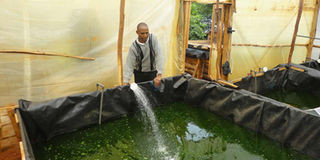All that you need to rear fish the modern way

James Mwaniki fills one of his fish ponds with water in his greenhouse in Runyenjes, Embu. The temperatures inside the greenhouse can go as high as the desired 30-35OC for tilapia and catfish farming. FILE PHOTO | NMG
What you need to know:
- Temperatures inside a greenhouse can reach 30-35OC.
- Tilapia and catfish prefer warm waters.
- Trout is farmed under intensive raceways and requires very cold, clean and running water.
- Use the drained water for irrigation.
Most people correctly believe that fish can only do well in warm water. However, some fish do well in very cold water and others in moderate temperatures.
An understanding of the climatic adaptability of fish species that are farmed can improve productivity. But more importantly, one can create a micro-climate through use of technology.
The technologies include greenhouses that are used to raise the internal temperatures to suitable levels for the warm water fish and above the ground fish ponds that enable fish to be grown in areas with limited water supply.
The fish to keep using these technologies are tilapia, catfish and rainbow trout.
Climatic adaptations
Tilapia and catfish prefer warm waters. Of the two, tilapia is the most favoured locally due to its marketability as well as its feeding preference of micro-plants making feeding and production affordable.
However, the love for catfish is rising while trout is a delicacy but expensive. Temperatures suitable for tilapia are between 20 and 35°C. Tilapia does not feed or grow at temperatures below 15°C.
Temperature is critical for breeding tilapia, with mature fish being able to spawn (produce eggs for fertilisation to take place) about once a month all-year round.
Spawns stop at temperatures of below 20°C. Death begins to occur at 12°C, with few fish surviving temperatures below 10°C for any period of time. Catfish does well in temperatures of 26-33°C and temperatures below this range decreases growth rate.
Trout is farmed under intensive raceways and requires very cold, clean and running water. The favourable temperatures for production is 7-18°C, anything above or below the range lowers feeding and hence production and growth rate.
Greenhouses
They are used by fish farmers in two ways. The first one is in areas where the climatic temperatures fall below 15°C. Farmers should cover the pond area with ultra-violet treated lining material to warm the ponds using the greenhouse effect.
The second one is in drying of fish feeds where one is producing home-made rations. In the latter case, the greenhouse offers a protected heating and drying environment for the prepared feeds.
The temperatures inside the greenhouse can go as high as the desired 30-35OC for tilapia and catfish farming. Some farmers have been able to rear the cold water fish, rainbow trout, alongside tilapia through this environmental modification.
Above the ground fish ponds
A good number of earthen ponds suffer seepage into the ground, thus they need constant replenishment of water. This is a serious problem especially with recurrent droughts plus the farm water competition for household and livestock watering.
This problem has been overcome through use of pond liners. Another challenge of dug ponds is the land requirement and the permanent nature of the structure. However, the problem has been sorted out through installation of the “above the ground” fish ponds.
There are many ways of constructing these types of ponds but the simplest and cost-effective one is ponds made of timber/offcuts, fencing posts, a strong twine or rope and ultra-violet treated pond liner material.
To put up such a structure, say a 9m3 pond, one is expected to mark a 3x3 metre square on the ground where he intends to install the structure.
Then dig out 2ft deep holes on the perimeter with proper spacing where posts will be spaced. Put the posts in place, secure them from the inside with the offcuts, the smooth side facing inside, and leave about one feet at the top of the posts uncovered by the offcuts.
Spread the liner well in the inside of the structure up to 1m high. Fold the liner at the top to the outside of the top offcut. Run the rope all-round the top to secure the liner.
Place another offcut to fully bind the liner. The pond is now ready for stocking. This size of pond can be stocked with 200 monosex tilapia, or 100 catfish or 500 ornamental fish.
To retain the desired level of dissolved oxygen, one has to remove some water at regular intervals and replace it with clean water through splashing to allow pond aeration. Use the drained water for irrigation.
The other alternative is to install a 6-inch drain at the bottom of the pond and expel water when it turns dark green.
Practice intense feeding as per age and population. Growth period is seven to nine months and eight ponds are ideal for a good monthly harvest.




